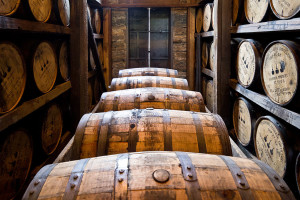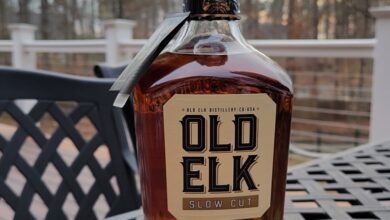The Short Cuts Around Aging Whiskey
Can Technology Shorten The Science Of Barrel Maturation?
By Richard Thomas

(Credit: Wikimedia Commons)
If public has been smothered with any one whiskey factoid lately, it’s that whiskey simply can’t be produced on demand. Actually, unaged whiskey can be made on demand, but the aged stuff takes longer, and boom times have left production decisions made several years ago a step or two behind the reality of modern demand.
Take Jim Beam, which filled a staggering one million barrels of whiskey between 2014 and 2016 and has two million barrels in its warehouses. Some simple math tells us that half of Beam’s inventory is two years old or less, and against this even the modest Jim Beam White hovers in the four to six year age range. In between is the situation that has driven Beam to take the age statement off of Jim Beam Black, Basil Hayden and Knob Creek. While not quite a shortage, it’s certainly an uncomfortable, if not painful, pinch.
The big distillers have a substantial investment, in brand identities, stock and infrastructure, tied up in making whiskey in the traditional way. Distillers in the burgeoning American craft distilling sector can choose to go a different route, however, and some have chosen to search for ways to get around traditional barrel maturation. In some cases, this meant reviving an old and disused practice, but others have resorted to new technology in their search short cut aging times.
Small Barrel Whiskey
As whiskey ages in the barrel, one of the things taking place is the absorption of sugars, tannins and other substances from the wood. One time-tested way to accelerate that particular process is to put more wood in contact with less whiskey by decreasing the size of the barrel.
A “small barrel” is one that holds less than the 53-gallon American Standard Barrel (ASB) that dominates the world’s whiskey industry. Using smaller barrels to age whiskey is not new (indeed, the precursor to the ASB held 48 gallons), nor is the practice limited to the U.S., but it is in the American craft whiskey sector that using small barrels has become a widespread practice.
Early in the craft whiskey movement, the use barrels holding five or ten gallons was fairly common. These very small barrels usually needed only three to six months to turn out a solidly amber-colored bourbon with strong vanilla flavors, but was also rather oaky. Furthermore, a six month old bourbon was still very youngish, despite the faster absorption of wood factors, because the use of a smaller barrel did not address any of the other aspects of maturation, such as esterification. Longer stays in these tiny barrels, however, made the whiskey cloyingly over-oaked.
This led to a meme that marred the early-to-middle stage of craft whiskey, “all craft whiskeys suck.” Nowadays the term “small barrel” usually refers to a 25- or 30-gallon cask, roughly half the size of an ASB and several times larger than a mere 5-gallon container. These bigger, but still small barrels allow for more than a mere several months of aging, while imparting wood factors faster than an ASB.
Another route to increasing wood surface contact is to do away with barrels altogether, and use an industrial version of the popular home-aging whiskey sticks. This is what Blue Ridge Distilling did in creating Defiant Malt Whiskey, using spiral-cut wood staves in an proprietary 60-day process, but one reminiscent of wine-makers using oak chips in place of oak barrels.
Whiskey Under Pressure
Small barrels have been the staple short cut response of small distillers, but some apply a more engineered solution. The first major example was Cleveland Whiskey, who rely upon using the aforementioned oak chips (chopped up barrel staves) in a pressurized stainless steel tank for six days, a process called “disruptive pressure-aging.”
Next came the TerrePURE process developed by South Carolina drinks firm Teressentia. Exactly how TerrePURE works is a secret, but it is reportedly based on the use of ultrasound technology, and also involves some heating and oxygenation. The point is to remove the volatile congeners from the whiskey, thereby accelerating another of the processes achieved in maturation.
As the TerrePURE process is applicable to all form of aged spirits, including unaged products like vodka, some form of wood aging must also be involved in creating TerrePURE whiskeys. Federal law requires at least a token amount of time spent in new oak for most major types of whiskey in any case. Terresentia whiskeys like Hatfield & McCoy have been seen with “aged a minimum of four months” on the label, a point suggesting very small barrel aging.
Unlike Cleveland Whiskey, Terressentia and its TerrePure process are not a small, local operation. They bought the Owensboro, Kentucky Charles Medley Distillery for $25 million, renovated it, and renamed it the O.Z. Tyler Distillery after the TerrePURE inventor.
The Whiskey Of Tomorrow
Thus far, the Irish and Scots have shown no interest in using technology to circumvent long aging time, and part of the reason why are laws specifying a minimum aging period of three years for their whiskeys. U.S. law only specifies that bourbon, rye and other major types of whiskey be aged in new white oak barrels, requiring no minimum aging period (to earn the additional designation “straight whiskey,” at least two years of aging is required). Cleveland Whiskey, for example, reportedly puts its new make in barrels for a short time to meet legal requirements, and then moves on to its disruptive pressure-aging.
In the U.S., the future of these methods depends on whether they can deliver competitive whiskeys at lower cost, but also on how the big distillers respond to them. The big bourbon companies have literally billions of dollars invested in traditional methods and the rules that define them. Many of the most hallowed standards in American whiskey (such as Bottled in Bond) were created to protect the interests of the big distillers of yesteryear, and as recently as 2013 Brown-Forman was adding to the rulebook to enhance Jack Daniel’s. If short-cutting time with technology actually starts to gain ground, expect the major liquor companies to either embrace the change or fight it with new laws and definitions in Congress.



One Comment